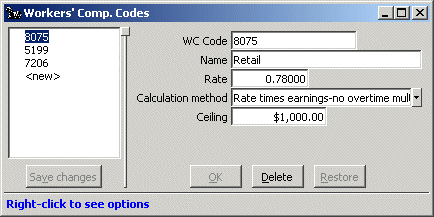21st Century Accounting Tutorials - Payroll
How do I set up Workers' Comp. Codes?
When you set up Payroll from scratch, set up all the Workers' Compensation classification codes that identify the kinds of Workers' Comp.-covered jobs assigned to your employees before you add Employees. Of course, you can modify and add Workers' Comp. Codes at any time.For more information at any field in the window, press F1: Help.
Follow these steps.
- Run Payroll/Configure/Workers' Comp. Codes.
- The official WC IDs identify the Workers' Compensation Codes
that apply to your employees.
- Names help identify each Workers' Compensation Code. The name might identify the kind of work associated with the code.
- The rate is assigned to each Workers' Comp. Code. You type the rate as you see it in your WCC documentation; for example, type a rate of 5.63 as 5.63.
- For each WC Code, select a calculation method from the options, as described below. The calculation method determines how the Workers' Compensation Report calculates the unadjusted "Premium" associated with the covered earnings or hours.
The Workers' Comp. calculation methods work as follows:
- Rate times earnings. The calculated WC "premium" on the Workers' Compensation Report is the rate you enter in this window times the calculated earnings (up to the ceiling, if there is one) for the factors that are assigned to WC Codes that use this rate.
-
Rate times earnings - no overtime multiplier. The calculated WC "premium" on the Workers' Compensation Report is the rate you enter in this window times the calculated earnings (up to the ceiling, if there is one) for the factors that are assigned to WC Codes that use this rate.
Earnings for overtime factors assigned to WC codes using this rate are calculated at the base factor rate (no Overtime multiplier).
-
Rate times hours. The calculated "premium" on the Workers' Compensation Report is the rate you enter in this window times the hours worked for the factors that are assigned to WC Codes that use this rate.
- A ceiling may be assigned to the Worker's Comp.-covered earnings associated with this WC Code.
The ceiling, if there is one, is taken into account across the transaction date range you specify when you print the report. The system does not track "earnings subject to" with and without ceiling as it does with taxes. For example, when you print the Workers' Compensation Report from April 1st of one year to April 1st of the next, if an employee's covered pay for that date range exceeds the ceiling, the pay is capped at the ceiling for the purpose of calculating a premium.
The ceiling field is disabled for Rate times hours.
- Now highlight <new> and press the Tab key.
- Configure the following WC Codes if you want to see the WC calculations reflected on the Workers' Compensation Report for the tutorial data:
WC Code Description Rate Calculation method Ceiling 8075 Retail .78 Rate times earnings
- no overtime multiplier1,000 OK 5199 Maintenance 2.79 Rate times hours NA OK 7206 Installation 1.45 Rate times earnings None OK - Click OK and Save changes.
Here is how a completed Workers' Comp. Codes window might look.

Read the information in Steps 2 - 7. Then fill in the Workers' Comp. Code windows with the data in Step 8.
